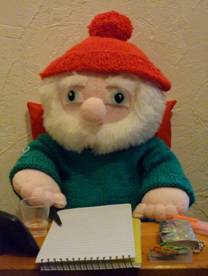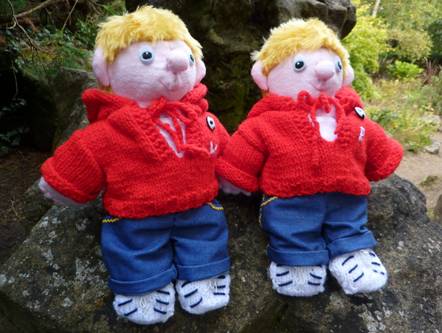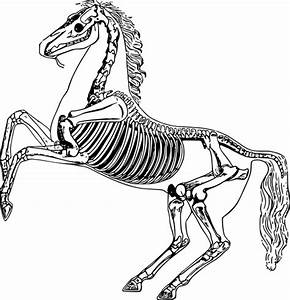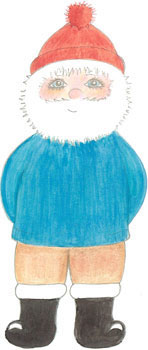
Salty Sam’s Fun Blog for Children
Number 544
Adaptability
Hello Everyone

Miss Pringle said something to her class this week which was very interesting.
She was telling her children about the very famous scientist called Charles Darwin.
He made a study of evolution and saw how some species of animals survived the struggle for existence over long periods of time and others did not.
Darwin said that it wasn’t the fittest or the strongest of animal species that survived, but the ones that could adapt to their environment, and any changing circumstances that occurred – because over very long periods of time, environments often do change.
Darwin said that animals need to find food, protect themselves from any predators that might want to attack them and reproduce their species – have babies.
lf a species had good characteristics for survival and passed them onto their babies, those offspring would benefit from them too.
He called this phenomenon Natural Selection but noted that the term Survival of the Fittest often used by his contemporary (a man alive at the same time), philosopher Herbert Spencer, was an even more accurate way of describing it.
Actually, Darwin thought the term ‘survival of the fitter’ was more accurate – that is to say that some animals were better at surviving in their environment than others – and would only continue be successful if they changed when their environment changed.
A species can thrive for a long time, then if their environment changes – maybe due to climate change for example, that species has to cope with the changing circumstances or die out.
Herbert was a sociologist (a sociologist is a person who studies the structures of society) and came up with the term after reading about Darwin’s observations of the natural world.
Darwin was to later use the phrase ‘survival of the fittest’ in the fifth edition of his book printed in 1869 (the fifth version printed) On The Origin of Species.
Because he used the phrase survival of the fittest in his book, many people think the phrase was coined (invented) by Darwin.
Darwin has become famous for using it.
Miss Pringle said that Darwin’s observations of animals could well be related to humans too.
She said that the only constant in the universe, is change.
That means that you can always be sure that change will happen.
Those people that accept that things in life change – and find a way to adapt themselves to the new circumstances are the people that thrive the most.
This relates to personal responsibility.
The people that don’t give up when the going gets tough are the best survivors.
People who hit hard times and realize that they will change back to better times again are wise and have far-sightedness.
She said that there is a popular saying that the children would do well to remember.
When life gives you lemons you must make lemonade; that means make the best of things and focus on what you can do to make things better rather than what you have no control over.
Some people seem luckier than others, but maybe it is their ability to turn failure around rather than have things always go well for them that makes them a success in life.
They have grit.
They have resilience.
They have adaptability.
They have versatility.
They have perseverance.
This is a good lesson to learn.
Bye bye everyone – don’t forget to subscribe to my blog!
Love and kisses
Salty Sam

www.christina-sinclair.com


Bill and Bob’s Joke of the Week![]()
![]()
Bob: What did the tree say when spring came?
Bill: l don’t know. What did the tree say when spring came?
Bob: What a re-leaf!

Salty Sam © Christina Sinclair 2015
Unauthorized use and/or duplication of material from this blog without express and written permission from this blog’s author and owner is strictly prohibited.
Links may be used to www.christina-sinclair.com

Picture Gallery

Charles Darwin
 Herbert Spencer
Herbert Spencer



 THE SALTY SAM NEWS DESK
THE SALTY SAM NEWS DESK

Miss Pringle, in the last few months, has been taking calligraphy classes so that she can write the names of the children in her class onto certificates they might receive for achievements in the classroom or in sport.
The classes were started as part of the skills share scheme started up in the community earlier in the year.
Lots of people in Rocky Bay took part, and it was a really interesting way to get sociable.
Some people were teachers in some classes, and learners in others.
There have been a lot of activities going on!
Miss Pringle has finished with the calligraphy classes now and intends to move onto scuba diving in the Rocky Bay swimming pool with a view to diving in the sea one day.

But she really liked her calligraphy teacher and asked him if he might come and give a talk to her class one day.
As an end of term treat, he came to give the children an art lesson.
He gave the children lots of tips and tricks about drawing.
He told them that when children draw people, they usually draw their arms coming out of their sides whereas arms really come from shoulders.
He explained that if you ever want to draw a realistic representation of a person or animal, the first thing you must do is understand what a skeleton looks like. This is because the whole body is built around it.

He had brought in a small model of a skeleton of a human and one of a horse.
The models could be put into different positions.

The skeleton of the horse would be pretty similar to that of a dog or cat or most animals that walk on all fours.

He showed them how to draw necks that went down into shoulders.
Then he showed them how to draw necks go up into a chin and then a face.
He showed them how to really focus on what the profile of a face looked like.
Hands are really difficult to draw and so he said to leave those for another day!
To finish the lesson he drew some balloon shapes on the board and ‘fleshed them out’ into cartoon characters standing in different poses. That was a lot of fun.
The children understood everything they were shown, and thought it was the best lesson they had had for a long time.


*********************
*********************

 Quick Quiz
Quick Quiz
What do these phrases mean?
- a broken reed
- a sea change
- a stick-in-the-mud
- doing a 180
- a budding designer
- work in progress
- in flux
- zero-based thinking
- dyed in the wool
- a broken record
- going great guns
- spinning too many plates




lt’s the Weekend!

HOW TO MAKE A LAYERED HOUSE
This would make an interesting drawing project.
It is a picture built up in layers.
The base picture is a garden with the shape of a house in the middle.
Draw the inside of the house inside the house shape.

Then draw the outside of the house and stick it onto the top of the inside of the house with a piece of clear sticky tape.
You can lift up the outside of the house and see what is going on inside!
You could make the picture more complicated by drawing the garden and then stick three layers on top.
Then you could see the front of the house, the inside of the front rooms, the inside of the back rooms and then the garden behind the house.
You can make your house as big or small as you like.
You can draw a simple, fun picture or a complicated, realistic one!

Please note that the material on this blog is for personal use and for use in classrooms only.
It is a copyright infringement and, therefore, illegal under international law to sell items made with these patterns.
Use of the toys and projects is at your own risk.
©Christina Sinclair Designs 2015


Quick Quiz Answers
- a broken reed – a person who keeps changing direction – like a broken reed that changes position according to which way the wind is blowing
- a sea change – a change or decision which creates a situation going in the opposite direction
- a stick-in-the-mud – a person who won’t change or try anything new
- doing a 180 – suddenly going in the opposite direction
- a budding designer – someone beginning to show how much potential they have – it does not have to be a designer, it can be someone working in any field of work
- work in progress – a project not finished but moving forward
- in flux – always changing direction
- zero-based thinking – starting again – making fresh decisions about a situation – reassessing a situation and starting from the beginning
- dyed in the wool – someone or something stuck in their old ways
- a broken record – someone who keeps saying the same things
- going great guns – making really good progress
- spinning too many plates – taking on too many projects to successfully handle

The Moon is always changing
It is always in flux


